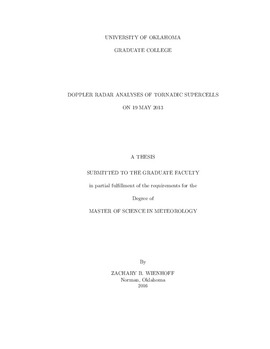| dc.description.abstract | On 19 May 2013, two supercells moved through central Oklahoma and produced seven tornadoes, including one of EF-3 and one of EF-4 intensity. High temporal and spatial resolution observations were collected in both strong tornadoes by a mobile, rapid-scan, X-band, polarimetric radar (RaXPol). In conjunction with the nearby WSR-88D Twin Lakes radar, dual-Doppler analyses were synthesized to produce the three-dimensional wind field and vertical vorticity throughout the tornadoes' lifecycles. In order to account for significant differences in the temporal resolutions of the two radars, a reflectivity-tracking scheme was employed to interpolate linearly (in a Lagrangian sense) between two radar volumes through a variational algorithm. Previous studies have performed dual-Doppler syntheses with an S-band radar and a non-rapid-scanning mobile radar (e.g., Markowski et al., 2012a; Tanamachi et al., 2012; Kurdzo et al., 2015); however, the analyses in this study are unique because they are one of the first, to the authors' knowledge, to make use of data from both an operational, S-band radar and a mobile, rapid-scan, X-band radar.
This work focuses on the methodology used to combine both RaXPol and KTLX datasets, including discussion regarding the strengths and weaknesses of this technique. Analyses are presented on the both the Edmond-Carney and Norman-Shawnee tornadoes, examining the characteristics of the wind field associated with the intensification, maturity, and demise of the tornado. The 3-D wind fields of the tornado and mesocyclone are examined to see how they evolved in time, and especially how vertical vorticity and vertical velocity changed as the tornado intensified. Differential reflectivity (ZDR) from the WSR-88D is compared to the vertical velocity field estimated from dual-Doppler analyses to examine how the characteristics of a ZDR column varied with respect to changes in the updraft intensity. Results from both cases are compared, and some thoughts on future investigations using this technique will be presented. | en_US |
